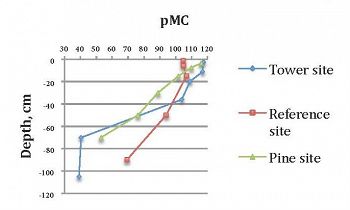Cherkinsky & Ehlinger, 2016
Effect of agriculture and reforestation on turnover rates SOM in ultisol profiles, Calhoun CZO
Cherkinsky, A., and R. Ehlinger (2016)
American Geophysical Union 2016 Fall Meeting, San Francisco, CA
-
Calhoun, INVESTIGATOR
Abstract
We have studied the distribution of 14C in Ultisols located in the Sumter National Forest. There were analyzed three sites:1) reference site was not presumably used for agriculture; 2) “Tower site”was used for the cotton growing from the beginning of 19thcentury till 1920s, in 1935 became National forest and was naturaly re-forested; 3) “Pine site” with the same original history as “Tower site”, but in the beginning of 1960s was planted with pine which was harvested and then planted again.
The performed experimental test were aimed to find out the distribution of 14C in the same soil type under different kind of forest replanted after the deforestation and land use them for growing cotton for more than 100 years. According to Richter et al.[1] surface mineral soils have sequestered minimal carbon over 5 decades of forest development due to rapid decomposition rates of organic carbon input. However, our data show mean residence time (MRT) of carbon in the tower and pine sites is an least about 25 years in the top 10-15 cm, where accumulated more than 95% of the entire SOM.
On the contrary the reference site, which presumably has original hardwood forest the decomposition rates of SOM is more than 3 times faster according to MRT , which about 8 years for the top 10 cm. These results allow to estimate the rates of accumulation and decomposition of SOM and their changes under changes of land use and climate changes.
For the first time were dated such deep Ultisol soil profiles. The turnover rates in the top organic rich horizons depends on the quality of the liter, conifer liter is more resistant to decomposition and the hard wood liter decompose faster. The dating of top 50-60 cm shows the quite fast turnaround time, which does not exceed a few decades, more likely 60-50 years. The deep horizons are quite stable and turnover rates deeper 60 cm dramatically drop to thousands years. The turnover rates for C horizon are older than ten thousands years. The deep horizons are very poor with organic C and deep penetrated pine roots affect turnover rate more than hard wood trees, which have mostly surface root distribution.
Citation
Cherkinsky, A., and R. Ehlinger (2016): Effect of agriculture and reforestation on turnover rates SOM in ultisol profiles, Calhoun CZO. American Geophysical Union 2016 Fall Meeting, San Francisco, CA.
 This Paper/Book acknowledges NSF CZO grant support.
This Paper/Book acknowledges NSF CZO grant support.
Explore Further


